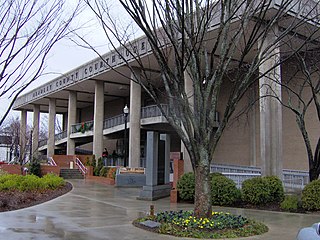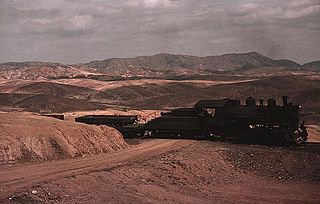
Bradley County is a county located in the southeastern portion of the U.S. state of Tennessee. As of the 2020 census, the population was 108,620, making it the thirteenth most populous county in Tennessee. Its county seat is Cleveland. It is named for Colonel Edward Bradley of Shelby County, Tennessee, who was colonel of Hale's Regiment in the American Revolution and the 15th Regiment of the Tennessee Volunteers in the War of 1812. Bradley County is included in the Cleveland, Tennessee Metropolitan Statistical Area, which is also included in the Chattanooga-Cleveland-Dalton, TN-GA-AL Combined Statistical Area.

Charleston is a city in Bradley County, Tennessee, United States. The population was 664 at the 2020 census. It is included in the Cleveland Metropolitan Statistical Area.

Cleveland is the county seat of and largest city in Bradley County, Tennessee, United States. The population was 47,356 at the 2020 census. It is the principal city of the Cleveland metropolitan area, Tennessee, which is included in the Chattanooga–Cleveland–Dalton, TN–GA–AL Combined Statistical Area.
Hopewell is a census-designated place (CDP) and unincorporated community in Bradley County, Tennessee, United States. The population was 1,874 at the 2010 census. It is included in the Cleveland, Tennessee Metropolitan Statistical Area.

Calhoun is a town in McMinn County, Tennessee, United States. It is part of the Chattanooga–Cleveland–Athens combined statistical area. The population was estimated at 536 in 2020.
Chatata, meaning "clear water", is the original Cherokee name of an area located in Bradley County, Tennessee. Today the name survives in references to a number of locations in Bradley County, most notably Chatata Valley in the northeastern part of the county. Chatata was also the original name of an unicorporated community in this region now known as Tasso.
The Blue Ridge and Atlantic Railroad of the United States purchased the Cornelia-Tallulah Falls section of the North Eastern Rail Road in an attempt to connect Savannah, Georgia to Knoxville, Tennessee. Chartered in 1887, it went bankrupt in about 1892 and in 1898 its properties became part of the newly formed Tallulah Falls Railway.

Red Clay State Historic Park is a state park located in southern Bradley County, Tennessee, United States. The park was the site of the last capital of the Cherokee Nation in the eastern United States from 1832 to 1838 before the enforcement of the Indian Removal Act of 1830. This resulted in a forced migration of most of the Cherokee people to present-day Oklahoma known as the Cherokee removal. The site is considered sacred to the Cherokees, and includes the Blue Hole Spring, a large hydrological spring. It is also listed as an interpretive center along the Trail of Tears National Historic Trail.

Whiteside is an unincorporated community in Marion County, Tennessee. It was originally settled as a Cherokee town in the late eighteenth century.

The Chunky Creek Train Wreck occurred on February 19, 1863, when a train crashed into the creek from a bridge damaged by heavy rain on the Southern Rail Road line between Meridian and Vicksburg, Mississippi.

During the American Civil War, most of what is now the U.S. state of Oklahoma was designated as the Indian Territory. It served as an unorganized region that had been set aside specifically for Native American tribes and was occupied mostly by tribes which had been removed from their ancestral lands in the Southeastern United States following the Indian Removal Act of 1830. As part of the Trans-Mississippi Theater, the Indian Territory was the scene of numerous skirmishes and seven officially recognized battles involving both Native American units allied with the Confederate States of America and Native Americans loyal to the United States government, as well as other Union and Confederate troops.

The Cherokee in the American Civil War were active in the Trans-Mississippi and Western Theaters. In the east, Confederate Cherokees led by William Holland Thomas hindered Union forces trying to use the Appalachian mountain passes of western North Carolina and eastern Tennessee. Out west, Confederate Cherokee Stand Watie led primarily Native Confederate forces in the Indian Territory, in what is now the state of Oklahoma. The Cherokee partnered with the Confederacy in order to get funds, as well as ultimately full recognition as a sovereign, independent state.

The East Tennessee bridge burnings were a series of guerrilla operations carried out during the American Civil War by Union sympathizers in Confederate-held East Tennessee in 1861. The operations, planned by Carter County minister William B. Carter (1820–1902) and authorized by President Abraham Lincoln, called for the destruction of nine strategic railroad bridges, followed by an invasion of the area by Union Army forces then in southeastern Kentucky. The conspirators managed to destroy five of the nine targeted bridges, but the Union Army failed to move, and would not invade East Tennessee until 1863, nearly two years after the incident.

Blue Springs Encampments and Fortifications is the site of a Civil War military encampment in Bradley County, Tennessee. Union Army forces commanded by General William Tecumseh Sherman camped at this location between October 1863 and April 1865. Entrenchments built on the crests of ridges overlooking the camps are still visible on the site. Stone reinforcements are present in some sections of the entrenchments.
The C.S.M. Paul B. Huff Medal of Honor Memorial Parkway, more commonly known as Paul B. Huff Parkway or Paul Huff Parkway, is a major east–west thoroughfare which runs through northern Cleveland, Tennessee. While not a numbered highway, it serves as a connector between U.S. Route 11 (US 11) and State Route 60 (SR 60) as well as to Interstate 75 (I-75), is maintained by the Tennessee Department of Transportation (TDOT), and has come to be one of the most heavily traveled and widely used roads in the city, with many corporate and private businesses locating to it. In 2017 the parkway had an annual average daily traffic (AADT) volume of 26,762 vehicles. The road is named in honor of Paul B. Huff, a Cleveland-born recipient of the Medal of Honor for his actions in World War II.
Richard Mitchell Edwards was an American attorney, politician and soldier who served one term in the Tennessee House of Representatives (1861–1862). A Southern Unionist, he represented Bradley County at the East Tennessee Convention in 1861, and served as colonel of the 4th Tennessee Cavalry of the Union Army during the Civil War. He ran unsuccessfully for governor on the Greenback Party ticket in 1878 and 1880.

Rattlesnake Springs is a historic site in Bradley County, Tennessee listed on the National Register of Historic Places (NRHP) in 1975.

The Copper Basin, also known as the Ducktown Basin, is a geological region located primarily in Polk County, Tennessee that contains deposits of copper ore and covers approximately 60,000 acres. Located in the southeastern corner of Tennessee, small portions of the basin extend into Fannin County, Georgia and Cherokee County, North Carolina. The basin is surrounded by the Cherokee National Forest and the cities of Ducktown and Copperhill, Tennessee and McCaysville, Georgia are located in the basin.
The Hiwassee River Heritage Center is a history museum located in Charleston, Tennessee which was established in 2013. The museum chronicles the region's Cherokee and Civil War history. It is a certified interpretive center on the Trail of Tears National Historic Trail.

The Battle of White Sulphur Springs, also known as the Battle of Rocky Gap or the Battle of Dry Creek, occurred in Greenbrier County, West Virginia, on August 26 and 27, 1863, during the American Civil War. A Confederate Army force commanded by Colonel George S. Patton defeated a Union brigade commanded by Brigadier General William W. Averell. West Virginia had been a state for only a few months, and its citizens along the state's southern border were divided in loyalty to the Union and Confederate causes. Many of the fighters on both sides were West Virginians, and some were from the counties close to the site of the battle.
















